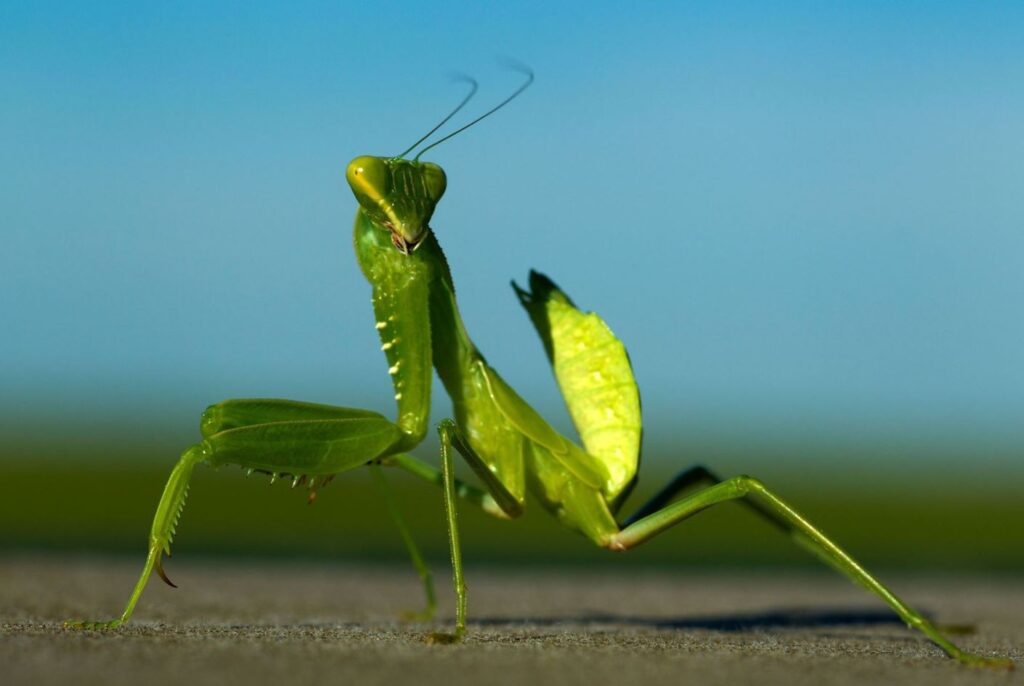Mantis religiosa, commonly known as the European mantis or praying mantis, is one of the most fascinating and predatory insects in the natural world. Known for its distinctive posture and predatory prowess, this insect captivates enthusiasts, scientists, and nature lovers alike. In this comprehensive article, we delve into the physical characteristics, behavior, habitat, distribution, and ecological importance of Mantis religiosa.

Physical Characteristics of Mantis religiosa
Mantis religiosa is a large insect, typically ranging from 40 to 80 millimeters in length. The species exhibits sexual dimorphism, where females are generally larger than males. Female mantises range from 48 to 76 millimeters, while males are slightly smaller, measuring 40 to 61 millimeters. The elongated, tubular thorax supports a triangular head that can rotate nearly 180 degrees, offering excellent field vision.
Key Features:
- Cylindrical Thorax: The elongated thorax provides agility and precision during hunting.
- Forelegs Designed for Predation: The forelegs are equipped with sharp spines, resembling scythes, enabling the mantis to capture and hold its prey firmly. These forelegs are also adorned with a distinctive black spot, often highlighted by a central bright dot.
- Camouflaged Coloring: The mantis’ coloration varies based on its environment. It ranges from vibrant green to muted browns and yellows, ensuring effective camouflage against predators and while hunting.
- Wings: Mantis religiosa has two sets of wings. The forewings are narrow and serve as a protective covering for the broader hind wings, which resemble translucent panes of glass.
Behavior and Feeding Habits
Mantis religiosa is a carnivorous predator with a diet primarily consisting of other insects. Its hunting method relies on stealth and precision, making it one of nature’s most efficient insect predators.
Diet:
Mantis religiosa primarily preys on:
- Aphids
- Flies
- Butterflies
- Beetles
- Moth larvae
- Grasshoppers
- Wasps
This species is also known for its cannibalistic tendencies, especially during mating. Female mantises often consume males either during or after copulation, a behavior believed to provide essential nutrients for reproduction.
Reproductive Behavior:
Females lay 100 to 300 eggs at a time, often during late summer or autumn. These eggs are encased in a frothy substance that hardens into a protective structure known as an ootheca. Depending on the season, eggs may hatch in as little as a month or remain dormant throughout the winter, emerging in the spring.
Habitat and Distribution
Mantis religiosa thrives in a variety of climates, ranging from temperate to tropical regions. Its adaptability has allowed it to establish populations across multiple continents.
Preferred Habitats:
- Forested areas
- Shrubs and bushes
- Grasslands
- Agricultural fields
While primarily arboreal, mantises are also found on smaller plants and tall grasses where prey is abundant. Their adaptability allows them to thrive in diverse ecosystems.
Geographic Range:
Originally native to Europe, Asia, and Africa, Mantis religiosa has spread to other continents, including North America and Australia. In Vietnam, it is widely distributed across provinces like Lạng Sơn, Quảng Ninh, and Quảng Bình, thriving in both rural and urban landscapes.
Ecological Importance
Mantis religiosa plays a crucial role in maintaining the balance of ecosystems by controlling populations of smaller insects, many of which are agricultural pests.
Benefits:
- Natural Pest Control: By preying on aphids and other destructive insects, mantises help reduce the need for chemical pesticides.
- Indicator of Biodiversity: A healthy population of Mantis religiosa often signals a thriving ecosystem.
However, this predator is not without its drawbacks. In certain instances, it may feed on pollinators like bees, which are vital for plant reproduction.
Conservation and Threats
Despite their adaptability, populations of Mantis religiosa are declining in some regions due to habitat loss, overuse of pesticides, and predation by natural enemies. Additionally, their cannibalistic nature and the collection of specimens by enthusiasts have also contributed to their rarity.
Conservation Status:
In Vietnam, Mantis religiosa is the only member of the Mantodea order listed in the Vietnam Red Book, emphasizing its endangered status. Many countries now recognize the importance of conserving this unique insect and have enacted protective measures.
Threats:
- Habitat Destruction: Urbanization and deforestation disrupt the natural habitats of mantises.
- Chemical Pesticides: Widespread pesticide use significantly impacts their populations by reducing prey availability and direct toxicity.
- Over-collection: The practice of capturing mantises for private collections further reduces their numbers in the wild.

Cultural and Scientific Significance
The praying mantis has captured the imagination of various cultures throughout history. In some societies, it is viewed as a symbol of patience and mindfulness, while in others, it is revered as a spiritual totem.
Scientific Research:
Mantis religiosa has been the focus of numerous studies, particularly regarding its predatory behavior, camouflage, and mating strategies. Researchers are also exploring its potential use in sustainable pest management systems.
Fascinating Facts About Mantis religiosa
- Head Mobility: The mantis is one of the few insects capable of turning its head 180 degrees, offering unparalleled hunting vision.
- Camouflage Mastery: Its coloration adapts to the environment, allowing it to blend seamlessly with foliage or dry grass.
- Predatory Precision: Mantis religiosa strikes with incredible speed, ensuring a high success rate when hunting.
- Unique Wing Design: The translucent hind wings resemble stained glass, adding to its ethereal beauty.
Conclusion
Mantis religiosa is more than just an insect; it is a symbol of balance, adaptability, and predatory elegance. As one of nature’s most efficient hunters, it plays an integral role in maintaining ecological harmony. By understanding and protecting this incredible species, we contribute to the preservation of biodiversity and the natural balance of ecosystems.